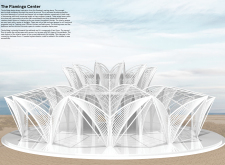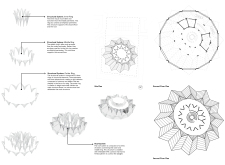5 key facts about this project
Key to the design is the use of concentric rings that create a dynamic exterior structure. The center features three primary rings, each varying in height and diameter, which together form a complex yet cohesive silhouette. This structural form promotes an interaction between the building and its natural surroundings, facilitating the flow of light and air while providing scenic views from within.
The architectural framework includes important materials such as steel and glass, which provide both structural integrity and transparency. The extensive use of glass in the facades allows for abundant natural light, enhancing interior spaces while fostering a connection to the outdoor environment. Furthermore, ETFE is used in the roof design, promoting energy efficiency and minimizing heat gain during warmer periods.
Unique Design Approaches
The Flamingo Center distinguishes itself through its innovative use of materials and construction techniques. The incorporation of ETFE as an inflatable material is noteworthy, as it not only enhances aesthetic appeal but also contributes significantly to sustainability efforts. This material allows for energy-efficient climate control within the building.
Another significant aspect of the design is the curvilinear staircase built from wood, which serves as a central element connecting the ground and second floors. This feature is not solely functional; it embodies the organic movement and fluidity characteristic of the project’s concept. The design encourages accessibility and promotes interaction among users throughout the space.
In addition to its visual appeal, the project aims to create a platform for various activities, including educational programs and community gatherings. The structure embodies a flexible environment that can adapt to different uses, from office work to community events. This adaptability makes the Flamingo Center a valuable resource for the local community.
Innovative Integration of Nature
A key focus of The Flamingo Center is the integration of nature into architectural design. The placement of the building in a wetland area reflects a sensitivity to environmental factors and emphasizes the importance of preserving natural habitats. The interaction between the building and landscape fosters an appreciation for the surrounding ecosystem, encouraging users to engage with nature.
Careful attention has been given to the landscaping around the building, which complements the architectural form while enhancing the user experience. The design promotes biodiversity and supports local flora and fauna, positioning the Flamingo Center as an ecological asset.
For a comprehensive understanding of the Flamingo Center's architectural significance, including architectural plans, architectural sections, and architectural designs, readers are encouraged to explore the detailed project presentation. This exploration offers deeper insights into the strategies and concepts that underscored the development of the Flamingo Center, showcasing the thoughtful integration of architecture and environment.


























